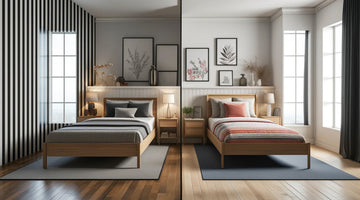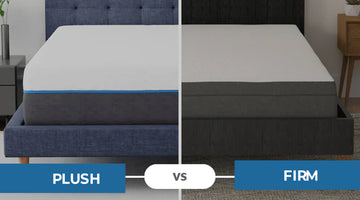Choosing the right bed size is crucial for a comfortable and restful sleep. It is common practice to consider both the Twin and full beds while designing your bedroom. This blog is a comprehensive approach and detailed comparison of Twin vs Full Bed. Twin beds are ideal for children and teenagers or guests in a shared room. They are also a good option for smaller bedrooms. Full beds offer more space than twin beds. This feature makes them comfortable sleeping alone or with a partner. They are suitable for individuals or couples with limited space.
Twin vs Full Bed: Size Comparison
The ideal size for your bed depends upon the dimensions of your bedroom and your desired size of sleeping bed. Not so much difference in the size of both the Twin and full beds have but the average dimensions of these beds are as given.
-
Twin: 38 inches wide by 75 inches long.
-
Full: 54 inches wide by 75 inches long.
Twin vs Full Bed: Which is Budget-Friendly?
Twin beds are generally more budget-friendly than full beds. The reason behind this cost reduction is that twin mattresses and bed frames tend to cost less. Their smaller size As compared to the full beds, reduces their overall cost for both the construction and design. This translates to lower upfront costs. Moreover, finding affordable bedding like sheets, duvets, comforters, and blankets is usually easier and cheaper for twin beds. The prices and the rates of the bedding mattresses suddenly touch the sky, especially in the winter season. Let's choose the best
Twin vs Full Bed: Which is Easy to Move?
Twin beds are easier to move than full beds. This is because of their smaller sizes compared to the full beds. Their smaller size and lighter weight make them more manageable for transport and maneuvering in tight spaces. It also reduces the labour cost for the transport of such beds from one location to another location. Moving a twin bed through doorways and up and down stairs is typically simpler. This makes them a more practical choice for frequent moves, smaller homes, or limited storage spaces.
Twin vs Full Bed: Mattress Size Requirements
Twin bedding mattresses measure 38 inches wide by 75 inches long. Full mattresses are significantly larger, measuring 54 inches wide by 75 inches long. This extra width provides more space for sleeping and allows for comfortable sharing for couples or accommodating a child. However, full beds require more floor space in the bedroom.
Twin vs Full Bed: Which Lasts Longer?
Mattress durability depends on several factors, not just size. Construction materials, like innerspring coils or foam, significantly impact lifespan. Higher-quality materials generally last longer. Usage patterns also play a role. Heavier individuals and frequent use can accelerate wear and tear on any mattress size.
Proper care extends mattress life. Regularly rotating and flipping (if applicable) helps distribute wear evenly. Using a mattress protector shields against spills and stains, preventing premature damage.
Twin vs Full Bed: Which is More Durable?
Generally, there's no inherent size-based difference in durability between twin and full beds. Both can be equally long-lasting with proper construction and care. To get more deeper insights, you can review bedding chart that explains the quality of the wedding material wedding.
However, full-size mattresses might experience slightly more stress due to their larger surface area. This can lead to faster wear and tear in areas of frequent use, like the center.
Ultimately, the most durable mattress, regardless of size, is one made with high-quality materials and cared for properly.
Twin Beds Explained
Twin beds are single beds designed for one person. They are smaller than full-size or queen-size beds, making them a popular choice for children, guests, or small spaces.
Construction and Design of Twin Beds
-
Standard Size: Twin beds typically measure 38 inches wide by 75 inches long.
-
Frame Materials: Frames are commonly made of wood, metal frame, or a combination of both.
-
Headboards: Headboards can vary greatly in style and material. Some are simple and minimalist, while others are ornate and upholstered.
-
Footboards: Footboards can be included for aesthetic purposes, but they are not always necessary.
-
Mattresses: Twin-size mattresses are designed to fit twin-size bed frames.
For Whom Twin Beds Are Suitable?
-
Children: Twin beds are ideal for children and teenagers.
-
Guests: They are perfect for accommodating guests in a spare room.
-
Small Spaces: Twin beds are a good choice for small bedrooms or dorm rooms.
-
Bunk Beds: Twin beds are the standard size for bunk beds.
Average Cost of Twin Beds in the United States
Do they are smaller in size when the quality is under consideration, the average cost of a Twin bed may start from 100$ to more than $1000. But this price range can get a discount when you go to a credible Cloudy Mattress in the market.
Accessories Required by Twin Beds
Twin beds are ideal for children and guests. To maximize comfort and functionality, consider these essential accessories:
-
Mattresses for twin beds: Choose a supportive mattress that aligns with the sleeper's needs.
-
Box springs for twin beds: These provide support and extend mattress life.
-
Bedding sheets and duvets: Include bed sheets, comforters, and pillowcases in coordinating colors and patterns.
-
Twin bed Pillows: Select comfortable pillows that provide proper neck and head support.
-
Headboards for twin beds: Add style and support for reading or sitting up in bed.
-
Bed frames for twin beds: Sturdy frames ensure stability and elevate the bed for easy access.
Full Beds Explained
Full beds, also known as double beds, are larger than twin beds and offer more sleeping space for one person or two smaller individuals.
Construction and Design of Full Beds
-
Standard Size: Full beds typically measure 54 inches wide by 75 inches long.
-
Bed Frame Materials: Full bed frames are commonly made of wood, metal, or a combination of both.
-
Headboards: Headboards come in various styles and materials, from simple to ornate.
-
Footboards: Footboards can be included for aesthetic purposes, but they are not always necessary.
-
Mattresses: Full-size mattresses are designed to fit full-size bed frames.
Full beds provide comfortable sleeping space for individuals or couples who prefer a bit more room than a twin bed.
For Whom Are Full Beds Ideal?
-
Couples: Full beds are a good option for couples who prefer to sleep close together.
-
Single Adults: They offer more space than a twin bed for single adults.
-
Growing Children: Full beds can accommodate growing children for a longer period.
-
Small Spaces: They can be a good choice for smaller bedrooms where space is limited.
Average Cost of Full Beds in the United States
Full size beds have different prices depending upon the structure, construction, and the material used in them. They can start from $500 to more than $1200 Depending upon the material used and the needs of the users hunting for comfort in full-size beds.
Accessories Required by Full Beds
Full beds are a popular choice for individuals and couples. To create a comfortable and stylish sleeping space, consider these essential accessories:
-
Mattresses for full bed and their size: Choose a mattress that provides adequate support and comfort for the sleeper(s).
-
No of Box springs per sq meter: Box springs are for proper mattress support and longevity. There is typically one box spring per square meter in a full bed mattress.
-
Using the Headboards in full beds: Enhance the aesthetic appeal and provide a comfortable backrest.
-
Bedding frames and components for full beds: Sturdy frames ensure stability and elevate the bed for easy access.
-
Bedding sheets and duvet sets for full beds: Include sheets, comforters, and pillowcases in coordinating colors and patterns.
-
Pillows: Select pillows that provide proper neck and head support for each sleeper.
-
Bedding accessories: Consider decorative throw pillows, blankets, and bed skirts to personalize the look.
Conclusion
Ultimately, the best choice between a twin and full bed depends on your individual needs and circumstances. Consider your available space, budget, and how you plan to use the bed. If you prioritize affordability, ease of movement, and suitability for children or guests, a twin bed might be the ideal choice. However, if you need more space for yourself or a partner, or plan to use the bed for a longer period, a full bed may offer greater comfort and longevity. Remember that proper mattress care, regardless of size, is essential for a good night's sleep and extending the lifespan of your investment.
FAQs
Which Occupies More Space, a Twin Bed or a Full Bed?
Full beds occupy more space than twin beds. A full bed is significantly wider than a twin bed, requiring more floor area.
Should I Buy a Twin or Full Bed for my Bedroom?
The best choice depends on room size, budget, and how you plan to use the bed.
-
Twin beds are ideal for children, guests, or small spaces.
-
Full beds offer more space for couples or individuals who prefer extra room. But along with occupying more space, they can provide comfort to more people.
Which is more comfortable for a Couple, Twin or Full Bed?
Full beds are generally more comfortable for couples than twin beds. Twin beds are best designed for one person. But they can be accommodated by two persons. However, the full bed has more surface area to provide comfort to more than one even more than 2 persons.
Does a Full Bed Require more Strength than a Twin Bed?
Full beds can be heavier and more difficult to move than twin beds due to their larger size and weight Since these kinds of beds are designed to accommodate more human mass, that's why they must be constructed with more durable material done twin beds.
What is the ideal size of a Twin Bed for Children?
The standard size for twin beds is 38 inches wide by 75 inches long. This size is suitable for most children and teenagers. So there are no worries to accommodate children on a twin bed.




